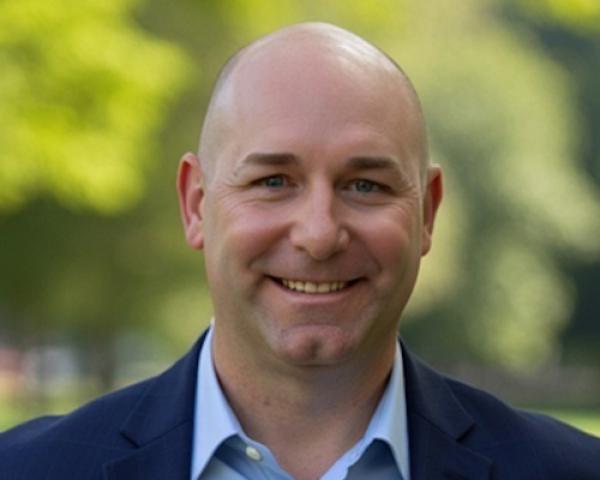Building Trust in the Sharing Economy
It’s tempting to think of the sharing economy as simply a new model of ownership, but that view misses the fundamental disruption.

It’s tempting to think of the sharing economy as simply a new model of ownership, but that view misses the fundamental disruption.

Get Involved
Our authors are what set Insurance Thought Leadership apart.
|
Partner with us
We’d love to talk to you about how we can improve your marketing ROI.
|

Tom Hammond is the chief strategy officer at Confie. He was previously the president of U.S. operations at Bolt Solutions.
Consumers increasingly value experiences above physical things. Can a new breed of protection products push them toward better health?

Get Involved
Our authors are what set Insurance Thought Leadership apart.
|
Partner with us
We’d love to talk to you about how we can improve your marketing ROI.
|

Ross Campbell is chief underwriter, research and development, based in Gen Re’s London office.
A Silicon Valley adage says one should never mistake a clear view for a short distance. The revolutionary potential of AVs is clear, but....

Successful industrialization of driverless cars will depend on getting over many significant hurdles. Failure only requires getting tripped up by a few of them. In part two of this series, I outlined seven key hurdles to industrial-size scaling of driverless cars. Overcoming hurdles to scaling is not enough, however.
In this concluding article, I explore the challenges to broader market acceptance. I outline eight additional hurdles related to trust, market viability and managing secondary effects. All must be overcome for driverless cars to truly revolutionize transportation. Trust. It is not enough for developers and manufacturers to believe their AVs are good enough for widespread use, they must convince others, too. To do so, they must overcome three huge hurdles: 8. Independent verification and validation. To date, developers have kept their development processes rather opaque. They’ve shared little detail about their requirements, specifications, design or testing. An independent, systematic process is needed to verify and validate developers’ claims of their AVs' efficacy. Many are likely to demand this, including policy makers, regulators, insurers, investors, the public at large and, of course, customers. The best developers should embrace this—it would limit liability and distinguish them from laggards and lower-quality copycats. 9. Standardization and regulation. Industry standards and government regulation cover almost every aspect of cars today. Industrialization of driverless cars will require significant doses of both, too. Standards, especially those enforced by government regulation, ensure reliability, compatibility, interoperability and economies of scale. They also increase public safety and reduce provider liability. 10. Public acceptance. Most new products take hold by attracting early adopters. The lessons and resources from that initial success help developers “cross the chasm” to mainstream success. The industrialization of AVs will depend on much earlier and broader public acceptance. AVs affect not only the early-adopting customers inside them, but also every non-customer on and near the roads those AVs travel. Without widespread acceptance—including by those who would not choose to ride in the AVs—industrialization is not likely to be allowed. See also: Where Are Driverless Cars Taking Industry? Market Viability. The next three hurdles deal with whether AV-enabled business models work in the short term and the long term, both in beating the competition and other opponents. 11. Business viability. Analyses of AV TaaS business models are generally optimistic about the possibility of providing service for much less than the cost of human-driven services or personal car ownership. Current cost-per-mile estimates are nowhere near long-term targets, however. Most players are also underestimating the cost to scale. It remains to be seen whether rosy market plans will survive contact with the marketplace. 12. Stakeholder resistance. As the old saying goes, one person’s savings is another’s lost revenue. The industrialization of driverless cars will require overcoming the resistance of a large host of potential losers, including regulators, car dealers, insurers, personal injury lawyers, oil companies, truck drivers and transit unions. This will not be easy, as the potential losers include some of the most influential policy shapers at federal, state and local levels. 13. Private ownership. AV TaaS services are only a waypoint on the path to transformation of the private ownership market. If AVs are to revolutionize transportation, they will have to appeal to consumers who have long preferred to own their own cars. Privately owned cars account for the vast majority of all cars and all miles driven. Secondary Effects. Technology always bites back. The industrialization of AVs could induce huge negative secondary effects. Most will unfold slowly, but two consequences are already concerning and must be addressed as part of the industrialization process. 14. Congestion. Faster, cheaper and better transportation will deliver greater economic opportunity and quality of life—especially for those who might otherwise not have access to it, like the poor, handicapped and elderly. But, it might also cause a surge in congestion by driving up the number of vehicles and vehicle miles traveled. This happened with ride-hail services, including Uber and Lyft. According to a recent study by the San Francisco County Transportation Authority, for example, congestion in the densest parts of San Francisco increased by as much as 73% between 2010 and 2016. The ride-hail services collectively accounted for more than half of the increase in daily vehicle hours of delay. 15. Job loss. Some argue that the history of technology, including transportation technology, shows that new services will create more jobs, not less. Few argue, however, that the new jobs go to those who lost the old ones. There’s no getting around the fact that every AV Uber means one less human Uber driver—even if other jobs are created for engineers, maintainers, dispatchers, customer service reps, etc. The same holds true for AV shuttles, buses, trucks and so on. Early AV TaaS providers will operate under an intense spotlight on this issue. Providers will have to anticipate and ameliorate potential public and regulator backlash on job loss. * * * There’s an old saying in Silicon Valley that one should never mistake a clear view for a short distance. The revolutionary potential of AVs is clear. Yet, we are still far from the widespread adoption needed to realize their benefits. Don’t mistake a long distance for an unattainable goal, though. As a close observer, I am enthusiastic (and pleasantly surprised) by the progress that has been made on AV technology. Leading developers like Waymo, GM Cruise, nuTonomy and their diaspora have raced to build AVs and progressed faster than many, just a few years ago, thought possible. See also: Driverless Cars and the ’90-90 Rule’ Industrialization is a marathon, not a sprint. It depends on overcoming many hurdles, including the 15 I’ve laid out. The challenges of doing so are great—likely greater than many current players (and their investors) perceive and are positioned to address. New strategies are needed. A shakeout is likely. That’s how innovation and market disruption work. That is why most contenders fail and why outsized rewards go to those who succeed. Whoever thought that a phone maker or a search engine company could be worth a trillion dollars? Is it outlandish to believe, as I still do, that driverless cars would be worth multiple trillions?
Get Involved
Our authors are what set Insurance Thought Leadership apart.
|
Partner with us
We’d love to talk to you about how we can improve your marketing ROI.
|

Chunka Mui is the co-author of the best-selling Unleashing the Killer App: Digital Strategies for Market Dominance, which in 2005 the Wall Street Journal named one of the five best books on business and the Internet. He also cowrote Billion Dollar Lessons: What You Can Learn from the Most Inexcusable Business Failures of the Last 25 Years and A Brief History of a Perfect Future: Inventing the World We Can Proudly Leave Our Kids by 2050.
Property/casualty claims is destined to transform more than any other area of the insurance business over the next decade.

Property/casualty claims is destined to transform more than any other area of the insurance business over the next decade.
Many may see that as a provocative statement, especially with all the attention on distribution and underwriting. After all, there are so many new entrants, insurtech startups and new technology solutions aimed at disrupting or transforming distribution and underwriting that it may seem difficult to justify the statement that claims will transform even more.
To be sure, distribution, underwriting and other areas of insurance are undergoing transformation and may look quite different a decade from now, with significant variations by line, of course. But, keep in mind that claims is already a complex and sophisticated part of the business, with high levels of expertise, extensive partner networks and major usage of technology. In addition, claims touch points are even more critical in today’s environment of heightened customer expectations and insurer focus on improving the customer experience.
See also: New Power Shift in P&C InsuranceBut back to the initial provocative statement – let me provide some rationale for why I believe claims will be very, very different a decade down the road. No one can predict exactly what claims will look like in 10 years, but here is a view on what is likely to change significantly – in some cases radically:
These areas will all warrant attention by claims executives. The drums of change are now beating – and real change will start to be felt in the next 12 to 18 months. When all these things are considered, I believe that major transformation is in store for claims. And for many insurers, it is going to be earth-shattering.
Get Involved
Our authors are what set Insurance Thought Leadership apart.
|
Partner with us
We’d love to talk to you about how we can improve your marketing ROI.
|

Mark Breading is a partner at Strategy Meets Action, a Resource Pro company that helps insurers develop and validate their IT strategies and plans, better understand how their investments measure up in today's highly competitive environment and gain clarity on solution options and vendor selection.
A wellness program for Arkansas teachers shows how "pry, poke and prod" programs raise expenses while likely harming health.

 Phew! At least it’s free to taxpayers because Catapult’s expenses and profits are “already in your budget” and “fees are processed through your health plan.”
Except that the state of Arkansas is its own health plan. There is no “Don’t worry. Insurance will pay for it” here. The state is self-insured, meaning it picks up the tab, not some nameless insurance company.
But, hey, at least this program will save money, right?
The return-on-investment for the state is allegedly 3.27-to-1, as shown by the so-called “Harvard Study,” conducted by Katherine Baicker.
Except that the Harvard study has been proven wrong, not just by the nonprofit, nonpartisan highly respected RAND Corporation (and I myself chimed in, as well), but by an ace researcher named Damon Jones, part of the prestigious National Bureau for Economic Research. His work showed that wellness accomplishes virtually nothing other than the expenditure of money. (Don’t worry—insurance will pay for it.)
See also: Wellness Vendors Keep Dreaming
But, hey, maybe Professor Jones is wrong. After all, why should he care what Professor Baicker thinks, right?
Um, because he reports to her? Yep, he’s an associate professor at the exact same school of public health where she is now dean. Just guessing here, but it would seem a subordinate would have to be pretty darn sure of his findings (and they are rock solid, and completely in agreement with all the other recent research, summarized here) to publicly humiliate his own dean.
Even Baicker doesn’t defend her findings any more. She says: “It’s too early to tell.” That means she is running away from her very widely cited signature study, upon which essentially the entire wellness industry’s economic justification is based. This would be like Arthur Laffer, whose Laffer curve created supply-side economics, which has been used to justify two tax cuts, saying, “Well, maybe it’s not right. I dunno. Let’s wait and see.”
But, hey, at least forced wellness improves employee health, right?
Apparently not. Forcing people to get annual wellness checkups doesn’t benefit them, according to the New York Times, the New England Journal of Medicine, the Journal of the American Medical Association and Consumer Reports. (Before dismissing the credibility of those sources due to possible political bias, keep in mind that Newsmax, the Federalist and Laura Ingraham hate “pry, poke and prod” programs, too.)
Forced wellness also takes teachers away from the classrooms to be pried, poked and prodded, stresses them out and hurts morale.
Further, sending “record rates” of employees into lifestyle and disease management is classic hyperdiagnosis – braggadocio-fueled misunderstandings of the arithmetic of lab results, resulting in large numbers of people getting told they need coaching and care they don’t want or, in general, need. Nothing makes a wellness vendor happier than to hyperdiagnose as many employees as possible.
But, hey, maybe teachers are a special case. Maybe the impact of “pry, poke and prod” programs is different for them?
It sure is. The single school district for which the data has been compiled is Boise, Idaho. According to the wellness vendor’s own data, the health of the teachers got somewhat worse as a result of this pry, poke and prod program. (The vendor, an outfit called Wellsteps, also admitted that it flouted clinical guidelines and fabricated its only positive outcome. The company also previously admitted that costs went way up as a result of its program. The company later suppressed that admission. Wellness vendors are not known for their integrity.)
So the health of teachers may deteriorate, creating more medical expense. but don’t worry. Insurance will pay for it.
But, hey, at least the teachers like it, right?
According to Catapult, employees love the program. Ask the employees, and you might get a different impression. Indeed, I was tipped off to this program by an Arkansas teacher who hates it, like most of her colleagues do — and that’s before they learn that they are actually paying for it…keep reading.
Obviously, if teachers wanted to submit to a “pry, poke and prod” program, the state wouldn’t have to threaten them with massive fines – almost $1,000/year, which appears to be close to a record for any "pry, poke and prod" program anywhere — for refusing to let a private, out-of-state corporation play doctor on them at state expense.
But, hey, at least the state taxpayers save money by fining the teachers who don’t want to play doctor, right?
Actually, wellness makes claims costs go up, probably by more than the fines. There are lots of unneeded lab tests and other tests. For instance, the state of Connecticut admitted that, in addition to throwing away all its money on the actual wellness program, the state spent more on health care. The state comptroller who administered the program said the increased spending was “a good thing.” I guess he wasn’t worried because insurance was paying for it.
See also: Ethics of Workplace Wellness Industry
But, hey, at least the teachers don’t pay for it.
Actually, they do. The state’s human resources department brilliantly figured out that it could launder its wellness spending by hiring this outfit. By paying extra to Catapult (a multiple of what an effective wellness program would cost), the state is able to pick up the tab for wellness using the extra paperwork of a medical claim, as opposed to an outsized administrative expense in a separate line item. The latter would clearly need to be picked up by the taxpayers…and the state would have an incentive to control this highly visible figure.
By contrast, paying for “pry, poke and prod” as a medical claim will never be noticed, like Steve McQueen and David McCallum sprinkling the dirt from the tunnel around the stalag. On the other hand, the program will increase overall medical spending by 2% to 3% (the cost of the screening plus the added hyperdiagnosis expenses).
Here comes the evil genius part: At the next contract negotiation, the state can limit wage increases (or reduce benefits) by pointing out how high the health spending is.
So the teachers get pried, poked and prodded, hyperdiagnosed with hidden illnesses most of them don’t have – all against their will…and then they have to pay for the privilege in reduced wages.
Wow…the teachers are getting screwed. But, hey, at least they can’t sue the state, right, so taxpayers won’t have to pick up that bill, as well?
Starting in January, this program will be in blatant violation of two laws, the Americans with Disabilities Act and the Genetic Information Non-Discrimination Act. Those laws disallow forced wellness checkups but allow so-called “voluntary” ones.
Until recently, “voluntary” meant “do wellness or pay a big fine” like this one. But thanks to a lawsuit by AARP, the rules are changing in January so that “voluntary” must mean voluntary, like a dictionary would define the word. (This summary has the links to all you need to know about the case.) To get these fines back, teachers will be able to sue the state, possibly even as a class action, and possibly being awarded punitive damages. Exposure to lawsuits could cost the state millions more in addition to its current expenditure on Catapult Health.
And that doesn’t even cover the costs of a possible teacher walkout, like the one in West Virginia that was spurred in part by – you guessed it – the wellness program.
But, don’t worry. Insurance will pay for it.
Phew! At least it’s free to taxpayers because Catapult’s expenses and profits are “already in your budget” and “fees are processed through your health plan.”
Except that the state of Arkansas is its own health plan. There is no “Don’t worry. Insurance will pay for it” here. The state is self-insured, meaning it picks up the tab, not some nameless insurance company.
But, hey, at least this program will save money, right?
The return-on-investment for the state is allegedly 3.27-to-1, as shown by the so-called “Harvard Study,” conducted by Katherine Baicker.
Except that the Harvard study has been proven wrong, not just by the nonprofit, nonpartisan highly respected RAND Corporation (and I myself chimed in, as well), but by an ace researcher named Damon Jones, part of the prestigious National Bureau for Economic Research. His work showed that wellness accomplishes virtually nothing other than the expenditure of money. (Don’t worry—insurance will pay for it.)
See also: Wellness Vendors Keep Dreaming
But, hey, maybe Professor Jones is wrong. After all, why should he care what Professor Baicker thinks, right?
Um, because he reports to her? Yep, he’s an associate professor at the exact same school of public health where she is now dean. Just guessing here, but it would seem a subordinate would have to be pretty darn sure of his findings (and they are rock solid, and completely in agreement with all the other recent research, summarized here) to publicly humiliate his own dean.
Even Baicker doesn’t defend her findings any more. She says: “It’s too early to tell.” That means she is running away from her very widely cited signature study, upon which essentially the entire wellness industry’s economic justification is based. This would be like Arthur Laffer, whose Laffer curve created supply-side economics, which has been used to justify two tax cuts, saying, “Well, maybe it’s not right. I dunno. Let’s wait and see.”
But, hey, at least forced wellness improves employee health, right?
Apparently not. Forcing people to get annual wellness checkups doesn’t benefit them, according to the New York Times, the New England Journal of Medicine, the Journal of the American Medical Association and Consumer Reports. (Before dismissing the credibility of those sources due to possible political bias, keep in mind that Newsmax, the Federalist and Laura Ingraham hate “pry, poke and prod” programs, too.)
Forced wellness also takes teachers away from the classrooms to be pried, poked and prodded, stresses them out and hurts morale.
Further, sending “record rates” of employees into lifestyle and disease management is classic hyperdiagnosis – braggadocio-fueled misunderstandings of the arithmetic of lab results, resulting in large numbers of people getting told they need coaching and care they don’t want or, in general, need. Nothing makes a wellness vendor happier than to hyperdiagnose as many employees as possible.
But, hey, maybe teachers are a special case. Maybe the impact of “pry, poke and prod” programs is different for them?
It sure is. The single school district for which the data has been compiled is Boise, Idaho. According to the wellness vendor’s own data, the health of the teachers got somewhat worse as a result of this pry, poke and prod program. (The vendor, an outfit called Wellsteps, also admitted that it flouted clinical guidelines and fabricated its only positive outcome. The company also previously admitted that costs went way up as a result of its program. The company later suppressed that admission. Wellness vendors are not known for their integrity.)
So the health of teachers may deteriorate, creating more medical expense. but don’t worry. Insurance will pay for it.
But, hey, at least the teachers like it, right?
According to Catapult, employees love the program. Ask the employees, and you might get a different impression. Indeed, I was tipped off to this program by an Arkansas teacher who hates it, like most of her colleagues do — and that’s before they learn that they are actually paying for it…keep reading.
Obviously, if teachers wanted to submit to a “pry, poke and prod” program, the state wouldn’t have to threaten them with massive fines – almost $1,000/year, which appears to be close to a record for any "pry, poke and prod" program anywhere — for refusing to let a private, out-of-state corporation play doctor on them at state expense.
But, hey, at least the state taxpayers save money by fining the teachers who don’t want to play doctor, right?
Actually, wellness makes claims costs go up, probably by more than the fines. There are lots of unneeded lab tests and other tests. For instance, the state of Connecticut admitted that, in addition to throwing away all its money on the actual wellness program, the state spent more on health care. The state comptroller who administered the program said the increased spending was “a good thing.” I guess he wasn’t worried because insurance was paying for it.
See also: Ethics of Workplace Wellness Industry
But, hey, at least the teachers don’t pay for it.
Actually, they do. The state’s human resources department brilliantly figured out that it could launder its wellness spending by hiring this outfit. By paying extra to Catapult (a multiple of what an effective wellness program would cost), the state is able to pick up the tab for wellness using the extra paperwork of a medical claim, as opposed to an outsized administrative expense in a separate line item. The latter would clearly need to be picked up by the taxpayers…and the state would have an incentive to control this highly visible figure.
By contrast, paying for “pry, poke and prod” as a medical claim will never be noticed, like Steve McQueen and David McCallum sprinkling the dirt from the tunnel around the stalag. On the other hand, the program will increase overall medical spending by 2% to 3% (the cost of the screening plus the added hyperdiagnosis expenses).
Here comes the evil genius part: At the next contract negotiation, the state can limit wage increases (or reduce benefits) by pointing out how high the health spending is.
So the teachers get pried, poked and prodded, hyperdiagnosed with hidden illnesses most of them don’t have – all against their will…and then they have to pay for the privilege in reduced wages.
Wow…the teachers are getting screwed. But, hey, at least they can’t sue the state, right, so taxpayers won’t have to pick up that bill, as well?
Starting in January, this program will be in blatant violation of two laws, the Americans with Disabilities Act and the Genetic Information Non-Discrimination Act. Those laws disallow forced wellness checkups but allow so-called “voluntary” ones.
Until recently, “voluntary” meant “do wellness or pay a big fine” like this one. But thanks to a lawsuit by AARP, the rules are changing in January so that “voluntary” must mean voluntary, like a dictionary would define the word. (This summary has the links to all you need to know about the case.) To get these fines back, teachers will be able to sue the state, possibly even as a class action, and possibly being awarded punitive damages. Exposure to lawsuits could cost the state millions more in addition to its current expenditure on Catapult Health.
And that doesn’t even cover the costs of a possible teacher walkout, like the one in West Virginia that was spurred in part by – you guessed it – the wellness program.
But, don’t worry. Insurance will pay for it.
Get Involved
Our authors are what set Insurance Thought Leadership apart.
|
Partner with us
We’d love to talk to you about how we can improve your marketing ROI.
|

Al Lewis, widely credited with having invented disease management, is co-founder and CEO of Quizzify, the leading employee health literacy vendor. He was founding president of the Care Continuum Alliance and is president of the Disease Management Purchasing Consortium.
If you don’t trust your people enough to give them the opportunity to test the remote model, then why did you hire them?

Get Involved
Our authors are what set Insurance Thought Leadership apart.
|
Partner with us
We’d love to talk to you about how we can improve your marketing ROI.
|

Brent Williams is the founder and CEO of Benekiva, a configurable SaaS technology platform that transforms the end-to-end life claims and servicing experience. To learn more, download Benekiva’s white paper: “Elevate Your Claims Management with Benekiva's Modern Solutions”
Even in a heated marketplace, a superior customer contact center can let life insurers grow.

Get Involved
Our authors are what set Insurance Thought Leadership apart.
|
Partner with us
We’d love to talk to you about how we can improve your marketing ROI.
|

Tina Hammeke joined SE2 in 2016, with more than 30 years of experience across nearly every functional area of the business. This includes building operational infrastructure for startup ventures, as well as organizational management tools for mature operating units.

Thiru Sivasubramanian is the VP of architecture and technology strategy at SE2. Prior to SE2, he held technology leadership roles at Salesforce.com, Tata Consultancy Services and Torry Harris Business Solutions.

Many of you have seen the Gartner Hype Cycle curve. When a hot technology appears, it gets hyped and hyped until one day enough people become impatient, and sentiment turns against the technology. It then heads into what Gartner calls the Trough of Disillusionment. Eventually, the technology finds its role – often a major one – in the market.
The idea has always struck me as rather obvious (I described the curve to reporter colleagues on the tech beat at the Wall Street Journal years before I ever saw the Gartner chart), but Gartner popularized the notion, which is why it’s known as the Gartner Hype Cycle rather than, say, the Carroll Hype Cycle. Gartner is to be commended, because technologies can be plotted on the curve, and, drawing on history, their futures can be predicted with some confidence.
On the Carroll…er, Gartner Hype Cycle, the idea of technology-driven innovation in insurance seems to be heading into the Trough of Disillusionment (great name) among incumbents. A Lemonade or Trov hasn’t taken over the world. Big Tech is coming to insurance but not really here yet for most insurers. Industry executives seem to have read everything they care to about AI, blockchain, etc., and are starting to describe plans for small-bore improvements rather than truly innovative ones. Not total disillusionment, but headed in that direction.
Which brings me to the warning signs for 2019.
The slide into the Trough of Disillusionment creates real opportunities because prices of insurtechs will start to settle back toward reality. In any case, technologies keep maturing, no matter how we feel about them, so the day of reckoning in the market creeps closer all the time, and the slide toward disillusionment is the last opportunity for companies to position themselves before a host of technologies and startups will shake the insurance market.
If I’m right, 2019 may well be the last chance for insurance industry incumbents to start taking advantage of the opportunities presented by insurtech, or lose out to nimbler competitors. In that spirit, my colleagues and I at ITL pulled some thoughts together for incumbents on:
10 Signs You’re Headed for Trouble in 2019
Bonus warning sign: You make television commercials criticizing innovative companies.
In "The Sun Also Rises," a character is asked how he went bankrupt. "Two ways," he says, "gradually, then suddenly." We’re still in the "gradually" part of innovation driven by insurtech, but "suddenly" is coming. I suggest insurance industry incumbents view 2019 and warning signs like these as a last warning to get moving and avoid innovation bankruptcy.
Paul Carroll
Editor-in-Chief
Get Involved
Our authors are what set Insurance Thought Leadership apart.
|
Partner with us
We’d love to talk to you about how we can improve your marketing ROI.
|

Paul Carroll is the editor-in-chief of Insurance Thought Leadership.
He is also co-author of A Brief History of a Perfect Future: Inventing the Future We Can Proudly Leave Our Kids by 2050 and Billion Dollar Lessons: What You Can Learn From the Most Inexcusable Business Failures of the Last 25 Years and the author of a best-seller on IBM, published in 1993.
Carroll spent 17 years at the Wall Street Journal as an editor and reporter; he was nominated twice for the Pulitzer Prize. He later was a finalist for a National Magazine Award.
The need for insurance agents will grow 10% faster than the overall job growth average through 2026. Digital natives must fill the gap.

The need for insurance agents will grow 10% faster than the overall job growth average between now and 2026, the U.S. Bureau of Labor Statistics reports. Yet hiring in the insurance industry remains precarious, with only temporary periods of stabilization, The Jacobson Group says. As digital natives form an ever-increasing percentage of the workforce, this tech-savvy demographic will become the backbone of our organizations. Ed Kooijman, head of operations at 12CU, adds that many traditional organizations will adopt digital natives as leaders as a key strategy for getting ahead. This gives rise to an important question: How are P&C insurance companies preparing to attract and retain a workforce consisting primarily of digital natives? The truth is that property and casualty insurers face multiple challenges when it comes to recruiting and retaining digital natives. To attract digital native workers and stay competitive, P&C insurers are changing their approach in several ways. Creating a Digital-Friendly Workspace The term digital native is used to describe workers who grew up in today’s high-speed, screen-focused digital environment. When used in a hiring context, this term helps explain what millennials and Gen Z expect from the workplace. As more digital natives occupy the workforce, adapting modern workspaces is a predictable response. In fact, workspaces have changed with every generation to leverage emerging technological assets and meet new demands, Nick Mason writes at OfficeSpace Software. Nevertheless, the changes occurring in modern workspaces differ from those experienced by previous generations. Today’s digital natives expect to be able to communicate and collaborate easily whether or not they occupy the same physical space, PwC technology leader Antonia Cusumano explains. They want to collaborate to produce results more than they want to clock a specific number of hours in the work day or week. Digital natives’ focus on collaboration and results has changed their view of the office. “The workplace is no longer a specific destination where employees gather,” CIO contributor Paul Chapman says. He explains that working is more about a mindset than a physical location. “83% of workers don’t think they need an office in order to be productive.” To this end, insurance companies seeking to enhance their internal culture with the digital native perspective need technologies that match or exceed the tools these workers already use daily. According to John Mancini at the Association for Intelligent Information (AIAA), organizations that fail to adopt new technologies will struggle to attract and retain the industry’s best digital native talent. See also: Winning With Digital Confidence Using outdated, siloed systems is confusing and inefficient in the minds of digital natives, IO Integration contributor Mike Watson says. This is especially true because millennials are well-versed in technologies that empower smart, dynamic collaboration across remote and in-person teams. Making Information Easy to Access The internet provides the foundation of the digital native experience and helps define their approach to the world. Marie Puybaraud at Work Design Magazine explains that cloud-based data, along with multi-platform connections, provide digital native workers with instant, streamlined access to social and professional networks. This is why dark data, or siloed data that isn’t being used to make better decisions, can frustrate digital native workers. They’re accustomed to information being readily accessible, and they see this as a fundamental aspect of strong decision-making. Digital natives usually see technology as a tool rather than a solution, writer Jillian Richardson says. Consequently, insurance companies that invest in the latest technology simply to do so may be pushing these workers away, rather than attracting them. A clear goal for technological tools like software platforms, along with a careful consideration of how the new technology will be implemented, can help companies create a digital and physical environment optimized for these employees. It’s important to bear in mind, however, that while digital natives are comfortable with a wide range of technologies, they weren’t born with a complex understanding of cutting-edge tools like artificial intelligence or machine learning. Rather, digital natives have a lower learning curve for the technologies that are changing the insurance industry, says RapidValue marketing consultant Shuvro S. Sarkar. Similarly, multitasking isn’t a skill that digital natives have developed independently of previous generations. Although digital natives’ willingness to attempt multiple tasks at once is often higher than that of previous generations, their ability to succeed at those tasks is about the same, according to an October 2017 study published in Teaching and Teacher Education. Workspaces that allow digital natives some quiet time and space to focus on a single task remains essential. Speaking the Language of Digital Natives Insurance is also uniquely poised to speak the language of digital native generations. Digital natives may possess a confidence with technology that previous generations lacked, but they are keenly aware of the uncertainties in the broader world. Addressing this uncertainty within the context of insurance can make digital natives more interested in pursuing a career in the industry, says Michelle Tucker, global head of analyst training at AIG. “Insurance can provide some degree of certainty as a safety net supporting people’s lives and business pursuits,” Tucker says. “That idea really resonates with the individuals that we’re bringing into our organization.” The uncertainty that digital natives face in their overall lives is, in part, driven by the technology they are so comfortable using. Many are concerned, for instance, that the jobs they pursue at the start of their careers may be eliminated by technology, says Richard Partington, economics correspondent at the Guardian. This fear isn’t entirely unfounded in the insurance industry, says Peter Westerman, who works in product development at ALM. Highlighting the value of digital natives — and their ability to spot and implement insights that technology can’t replicate — is key to addressing these fears and hiring top-tier talent. See also: Workplace Wearables: New Use of Big Data In return, digital natives can help P&C insurers speak the language of their prospective and current client base. Younger generations are currently the most frequent users of new insurtech tools and systems, L’Atelier managing editor Sophia Qadiri says. Recruiting these natives can help established property and casualty insurers better adopt these customers’ viewpoints, making it easier to create the seamless digital experience this rising customer base demands. Like the rallying cry that early internet and software pioneers declared, the internet wants to be free. Today’s digital natives don’t always see information as free, but they do expect the information they need to be readily available when they’re pursuing a goal on the job. Attracting and retaining digital native staff can help property and casualty insurers better understand and address the changing world of insurance. To do so, these insurers will need to invest in technological tools that provide the information access and collaboration capabilities digital natives have come to expect from their technology.
Get Involved
Our authors are what set Insurance Thought Leadership apart.
|
Partner with us
We’d love to talk to you about how we can improve your marketing ROI.
|

Tom Hammond is the chief strategy officer at Confie. He was previously the president of U.S. operations at Bolt Solutions.
How much of what Waymo learns on Phoenix's polite streets applies to Boston's roundabouts or Beijing's pedestrian congestion?

Will driverless cars (AVs, for autonomous vehicles) live up to the revolutionary potential imagined by many, including me? In part one of this series, I asked whether AVs might develop like the Segway personal transporter and be relegated to narrow niche applications. To avoid going the way of the Segway, AV developers must overcome significant hurdles to scaling, trust, market viability and managing secondary effects.
In this article, I outline the challenges to scaling. Building and proving an AV is a big first step. Scaling AVs into industrial size and strength business operations delivering transportation as a service (TaaS) is an even bigger step. Here are seven giant hurdles related to scaling: 1. Mass production. Hand crafting or retrofitting a few thousand cars with AV technology is good enough for development and testing. Industrialization will require producing hundreds of thousands of cars at scale. But, as Tesla learned the hard way, building cars at scale is more complicated than it looks. 2. Electric charging infrastructure. Almost all AV efforts are being developed on top of electric vehicle (EV) platforms. Before EV fleets can operate at scale in any market, a whole new electric charging infrastructure must be built. This will take time and lots of money. 3. Mapping. The industrialization of the detailed, high-definition (HD) maps on which AVs depend limits where AVs can operate. Even though the cars are loaded with sensors, cameras and software, they need up-to-date maps to figure out where they are and what to do. See also: Driverless Cars and the ’90-90 Rule’ 4. Fleet management and operations. Industrialization will require flawless maintenance and efficient operation of tens of thousands of AVs widely distributed across large metropolitan service areas. Doing so will entail much more than cleaning windows and vacuuming carpets. It will entail maintaining complex computers on wheels. It will require complex predictive analytics to recharge, dispatch and load balance in response to spiky customer demand. Both public safety and business viability depend on this. 5. Customer service and experience. AV TaaS services are like a hospitality business built on a fleet of mobile hotel rooms with no on-property staff. Even the shortest trip can become arbitrarily messy and unruly—especially because there will be no human supervision in the car. Acceptable service and experience will have to extend to non-customers, as well, because AVs must interact with pedestrians, cyclists, other drivers, emergency personnel, other companies’ AVs and a host of other actors outside the car. 6. Security. Computer security is a challenging issue, in general, and networked armadas of computers on wheels will be attractive hacking targets. There are physical security issues, too. Physical security involving disgruntled drivers and bystanders, pranksters, thugs and others could also create security issues for both passengers and the public at large. 7. Rapid localization. How much of what Waymo and others are learning on the well-marked, well-lit, well-laid-out and relatively polite streets of Phoenix is transferable to the not-so-polite paved cow paths and roundabouts of Boston or the congested, pedestrian-filled city centers of New York, Paris and Beijing? Much—but not all. That is why every developer tests in multiple regions, to understand the peculiarities of local infrastructure, weather, cultural norms, etc. How fast and how well such localization can be done is another hurdle to scaling. See also: How to Adapt to Driverless Cars In part three of this series, I’ll explore the challenges to market acceptance. I will discuss eight industrialization hurdles that deal with trust, market viability and secondary effects.
Get Involved
Our authors are what set Insurance Thought Leadership apart.
|
Partner with us
We’d love to talk to you about how we can improve your marketing ROI.
|

Chunka Mui is the co-author of the best-selling Unleashing the Killer App: Digital Strategies for Market Dominance, which in 2005 the Wall Street Journal named one of the five best books on business and the Internet. He also cowrote Billion Dollar Lessons: What You Can Learn from the Most Inexcusable Business Failures of the Last 25 Years and A Brief History of a Perfect Future: Inventing the World We Can Proudly Leave Our Kids by 2050.